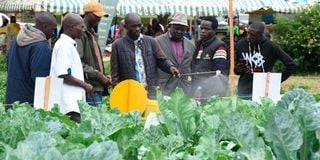Many families going without food due to high cost of living

Showgoers visit an exhibition stand at Chebororwa Agricultural Training Centre in Uasin Gishu County to mark World Food Day on October 16, 2023.
What you need to know:
- More organisations are coming out to offer food donations particularly in schools to prevent dropouts.
- Government is scaling up social safety nets with the growing need as researchers continue releasing worrying data.
Ms Florence Waithaka sits at her photocopy and printing shop in Ngara, Nairobi, hope almost palpable on her face, that the third client of the day could be somewhere on the way coming.
It’s around midday and she has had only two customers who sought photocopy services.
Of the many things she is sure to do on this sunny Friday — eating lunch is not on the menu.
And so when we approach the mother of three requesting an interview about “the state of life” and also to let her know that October 16 is World Food Day, one of the main things she wants to know is whether we will donate food to her.
“We hear that there is plenty of food in some parts of the country but it’s not getting to us. We are still buying food at high prices.
“Life has become difficult, nowadays. Many are the times we skip lunch and survive on one meal a day or cook more food in the evening so that we can consume the remaining share in the morning before leaving for work. Before, we used to have proper breakfast in the morning and we were always assured of lunch and supper. We would not eat food cooked the previous night but now things have changed. This is where we have reached in life,” she opens up.
She says ugali has become a more consistent dish on her family’s menu as it keeps people energetic for longer, and unlike several years ago when meat or sour milk would accompany the vegetables taken with ugali, they have had to cope with taking the staple with only sukuma wiki or other vegetables.
To beat the high cost of food amid dwindling incomes, Ms Waithaka, who lives in Umoja, spends Sh1,000 to buy food that lasts her family for two days, as buying daily would cost more.
Mr Jacob Mogambi, a resident of Majengo slums who operates a small roadside shop dealing in fast-moving foods and other products, also toils in the hot Nairobi sun at his shop located in Ngara, adjacent to the Thika Superhighway.
It has been a year since the father of three relocated to this place and it is not proving to be any better than where he came from.
At his home in the Majengo, his three children have also come to terms with surviving without food during the day. Why? Life has become hard, he says.
“I have had to cut my household budget, while I would give my wife about Sh500 daily, now I give her Sh300. With this, a balanced diet is no longer a consideration. We used to try and balance our diet back in the day, but nowadays we have to eat ugali almost on a daily basis. In the morning, we take what we cooked the previous night and wait until supper time,” Mr Mogambi says.
He partly attributes the poor performance of his business to the reality that many Nairobians around his environment have been forced to move upcountry after life became unbearable in the city. His shop has shed revenues from about Sh5,000 daily sales to a least of Sh1,000.
The picture painted by the two parents is similar on many fronts and represents struggles many households are feeling across the country. And on this World Food Day, lacking or largely short of food—life’s most essential thing—many can’t relate. Their struggles vary based on one’s locale, with households upcountry facing their own set of hardships.
But at the heart of it, a sharp spike in food prices and diminishing incomes as businesses struggle with high costs and taxes, and harsh climatic conditions that have lowered food productivity in the country. This has left many households burdened by high cost of living.
Many people are going without food. More organisations are coming out to offer food donations particularly in schools to prevent dropouts. The government is scaling up social safety nets with the growing need as researchers continue releasing worrying data.
At least 1.5 million Kenyans in 23 counties considered arid or semi-arid (Asals) will be in need of humanitarian assistance between this month and January 2024, the Kenya Food Security Steering Group projects in its latest report released in July.
While this projection is a drop from 4.4 million Kenyans who survived on aid by February, and 2.8 million by August, it remains a huge population, considering people such as Ms Waithaka and Mr Mogambi are going hungry despite living in areas that have not yet been considered for aid.
The Kenya Food Security Steering Group projected that in Turkana, Marsabit and Mandera, particularly, despite expected rains in the three months to January 2024, “one in five poor households will continue to face food crisis or worse outcomes, having been most impacted by the recent multi-seasonal drought.
“The households are likely to continue experiencing food consumption gaps forcing them to rely on unsustainable consumption and livelihood-based coping strategies indicative of crisis and emergency to bridge these gaps,” the organisations projected.
As the adults suffer, young children have been left to battle acute malnutrition, whose prevalence is expected to remain at critical phase running to January 2024 “due to atypically low food availability and poor dietary diversity, and increased morbidity from waterborne diseases, diarrhea, and malaria during the season.”
This is as food prices stay on an upward trend, which constraints households’ purchasing ability even when more food is available.
The latest data by the Ministry of Agriculture shows that maize production is expected to increase by 29.3 percent to 44.6 million bags this year, wheat by 62.6 percent to 4.9 million bags, beans by 56.3 percent to 11.7 million bags and irish potatoes by 26.3 percent to 25.3 million bags.
Prices of these food items, however, remain at an all-time high, with the Kenya Food Security Steering Group report indicating that most are retailing up to more than 100 percent of the five-year average.
Kenya National Bureau of Statistics (KNBS) data, on the other hand, shows that over the past six years, retail prices of some seven staple food items shot up by between 31 percent and 114 percent. The Nation analysed average prices of the food items over a three-month period (August to September) in the years 2018 to 2023.
The price of maize flour has risen by the highest margins since 2018, from Sh84 to Sh180 last month, followed by beans whose price increased by 78 percent to Sh185 for a kilo. A kilo of sugar, which currently retails up to Sh220, cost an average of Sh130 in the market in 2018, a 68 percent rise.
The price of wheat flour has also gone up by about 58 percent, from an average of Sh121 for a 2kg packet in 2018, to Sh191 by last month, based on official data by KNBS. The price of sukuma wiki, Kenya’s staple consumed alongside ugali by many households, has gone up from Sh45 in 2018 to Sh61 for a kilo by last month, while a kilo of irish potatoes- which cost Sh78 by 2018, is now over Sh100.
Reliance on heavy food imports has been a big contributor to high food prices in the country since the imports are susceptible to global geopolitical and logistical shocks, and poor performance of the local currency, which adds costs when purchasing imports any time it depreciates.
The latest economic data by KNBS on Kenya’s balance of payments also shows that the country’s expenditure on imported food went up by 40.7 percent, comparing the April- June periods of 2023 and 2022.
Money Kenyans spent to import rice alone more than doubled from Sh9.4 billion to Sh27 billion, on imported chemical fertilizers from Sh7.9 billion to Sh12.7 billion and the value of imported edible products increased by 77.2 percent to Sh7.2 billion.
“Under the broad economic category classification, expenditure on importation of food and beverage commodities registered the highest growth from Sh67.1 billion in the second quarter of 2022 to Sh94.4 billion in the same quarter of 2023,” KNBS stated in the April- June Balance of Payments (BOP) report.
High food prices deny poor households particularly the ability to afford key food items and some are forced to cut the number of times they eat or reduce portions as a coping mechanism.
A study in 2021 showed that nearly two-thirds of households in the country cut back on consumption, a fifth of households sought assistance from families and friends and others resorted to borrowing from shylocks, getting goods on credit or seeking additional jobs, to cope with high cost of living.
With the situation getting tougher experts have advised that Kenyans will have to shop around for cheap products in place of costlier ones that they have been used to, adopt strategies such as planting vegetables outside even if they live in towns, and add skills to grow their economic opportunities.
“Be resourceful with what is available, e.g if someone has a kitchen garden, they can use it to grow vegetables and fruits thereby reducing on how much is spent purchasing from shops. Also, attempt to get better value for money, including identifying discounted, bargain offers in the market,” says Mr Ken Gichinga, the Chief Economist at Mentoria Economics.
Kenya continues to be ranked among countries facing serious hunger situation by the Global Hunger Index (GHI), which last year gave the country a score of 23.5 and ranking at position 94 out of 121 nations, with regards to food security. The further a country is from the top, the more severe its hunger situation.
The Food and Agriculture Organization of the United Nations (FAO) and the Intergovernmental Authority on Development (IGAD) note that Kenya is in the region of eight countries with some of the hungriest people globally.
While extending a partnership to address critical agricultural and food security challenges facing the Eastern African region in August, FAO and IGAD noted that “approximately 56 million people in the region are currently facing severe levels of acute food insecurity - representing 25 per cent of the world's acute food-insecure population.”
The IGAD region comprises Kenya, Djibouti, Eritrea, Ethiopia, Somalia, South Sudan, Sudan and Uganda and among key issues causing food insecurity are ongoing conflicts, displacement, soaring inflation, and high energy costs.
Fews Net, a multinational organization that provides early warnings and analysis on acute food insecurity across the world, also notes that increased fuel prices are driving up food and non-food commodity prices, negatively impacting household purchasing power across the country. It is one of the members of the Kenya Food Security Steering Group.
“Staple food prices remain high, driven by atypically low market availability following successive below-average production seasons, high-priced cross-border imports from Tanzania and Uganda, and the high marketing costs due to increasing fuel prices,” Fews Net says in a September 29 report.
There is hope, however, that the rains expected between October and January 2024 will increase food productivity as crop and livestock flourish, but with a rider that projected El Nino rains will not lead to floods, loss of livestock and crops, especially many households still having not recovered from a multi-seasonal drought that ended only this year.
“Food security/insecurity in the country is highly dependent on rainfall, which overtime has become erratic and unpredictable owing to climate change,” notes the Kenya Food Security Steering Group.





